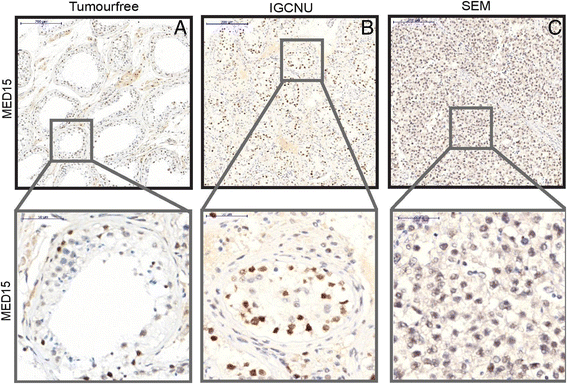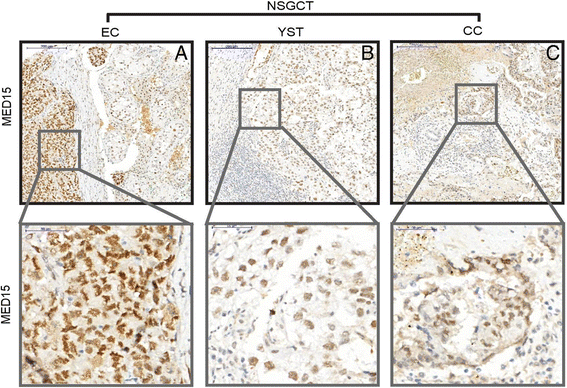Differential expression of Mediator complex subunit MED15 in testicular germ cell tumors
- PMID: 26377566
- PMCID: PMC4573996
- DOI: 10.1186/s13000-015-0398-6
Differential expression of Mediator complex subunit MED15 in testicular germ cell tumors
Abstract
Background: Testicular germ cell tumors (TGCT) are the most common cancer entities in young men with increasing incidence observed in the last decades. For therapeutic management it is important, that TGCT are divided into several histological subtypes. MED15 is part of the multiprotein Mediator complex which presents an integrative hub for transcriptional regulation and is known to be deregulated in several malignancies, such as prostate cancer and bladder cancer role, whereas the role of the Mediator complex in TGCT has not been investigated so far. Aim of the study was to investigate the implication of MED15 in TGCT development and its stratification into histological subtypes.
Methods: Immunohistochemical staining (IHC) against Mediator complex subunit MED15 was conducted on a TGCT cohort containing tumor-free testis (n = 35), intratubular germ cell neoplasia unclassified (IGCNU, n = 14), seminomas (SEM, n = 107) and non-seminomatous germ cell tumors (NSGCT, n = 42), further subdivided into embryonic carcinomas (EC, n = 30), yolk sac tumors (YST, n = 5), chorionic carcinomas (CC, n = 5) and teratomas (TER, n = 2). Quantification of MED15 protein expression was performed through IHC followed by semi-quantitative image analysis using the Definiens software.
Results: In tumor-free seminiferous tubules, MED15 protein expression was absent or only low expressed in spermatogonia. Interestingly, the precursor lesions IGCNU exhibited heterogeneous but partly very strong MED15 expression. SEM weakly express the Mediator complex subunit MED15, whereas NSGCT and especially EC show significantly enhanced expression compared to tumor-free testis.
Conclusions: In conclusion, MED15 is differentially expressed in tumor-free testis and TGCT. While MED15 is absent or low in tumor-free testis and SEM, NSGCT highly express MED15, hinting at the diagnostic potential of this marker to distinguish between SEM and NSGCT. Further, the precursor lesion IGCNU showed increased nuclear MED15 expression in the preinvasive precursor cells, which may provide diagnostic value to distinguish between benign and pre-malignant testicular specimen, and may indicate a role for MED15 in carcinogenesis in TGCT.
Figures



References
-
- Beyer J, Albers P, Altena R, Aparicio J, Bokemeyer C, Busch J, et al. Maintaining success, reducing treatment burden, focusing on survivorship: highlights from the third European consensus conference on diagnosis and treatment of germ-cell cancer. Ann Oncol. 2013;24(4):878–88. doi: 10.1093/annonc/mds579. - DOI - PMC - PubMed
Publication types
MeSH terms
Substances
Supplementary concepts
LinkOut - more resources
Full Text Sources
Other Literature Sources
Medical

